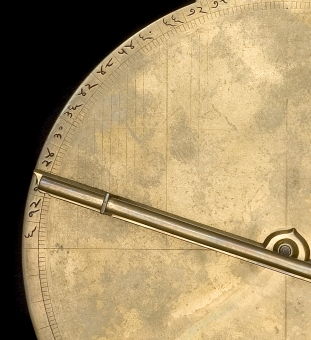| Date | 18th century |
| Place | India |
| Material | Brass |
| Inventory no. | 52478 |
| Acquisition | Presented by J. A. Billmeir in 1957 |
Like the other Indian (Sanskrit) astrolabe in the Museum's collection (inventory no. 30402 [ID 184]), this instrument was probably made in Jaipur, in Northern India. It shares a number of features common to astrolabes from Jaipur: the body is a single plate engraved for 27°, and there is a sighting tube affixed to the alidade on the back of the instrument. A number of the scales and other lines are unmarked, suggesting that the astrolabe is unfinished.
The sighting tube affixed to the alidade on the back of these Jaipur astrolabes has two adverse consequences. First, the large diameter of the tube would have limited the precision with which the altitude of a star could be measured. Further, although looking through a tube at a dim object, such as a star, is unproblematic, a sighting tube is inconvenient when trying to find the altitude of the sun, for the observer cannot look directly at the sun.
Special thanks to Professors S.R. Sarma and Chris Minkowski for their help transcribing and translating the Sanskrit on this instrument.
View all
images for this astrolabe
View
detailed provenance for this astrolabe
Mater
The mater and limb are of one-piece construction. Scales on the limb: degree scale. More informationBack
The back of this instrument is incomplete, having been engraved only in the upper left quadrant. The back contains 2 scales of the following types: Degree; Sine/Cosine. More informationRete, Nut & Bolt
The rete contains 27 stars. The zodiac on the rete is labelled: मे. , वृ. , मि. , क. , सि. , क. , तु. , वृ. , ध. , म. , कुं. , मी. .The rete is attached using a nut & bolt. The bolt and nut seem to be later additions.. More information
Rules & Alidades
| Type | Details |
|---|---|
| Alidade | Double-ended. A remarkable feature of this alidade is
the sighting tube attached to the two sights. It has a
large diameter and might have been used for sighting at
night.. |



